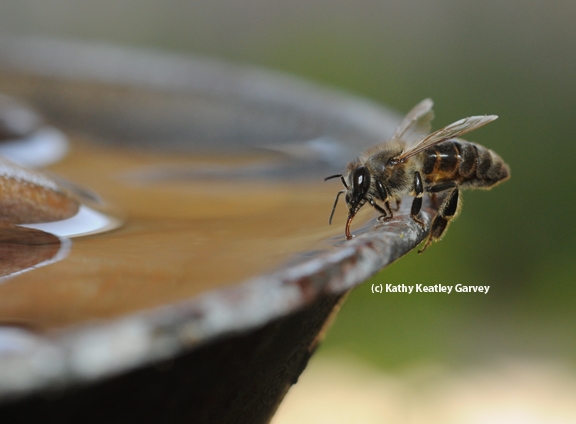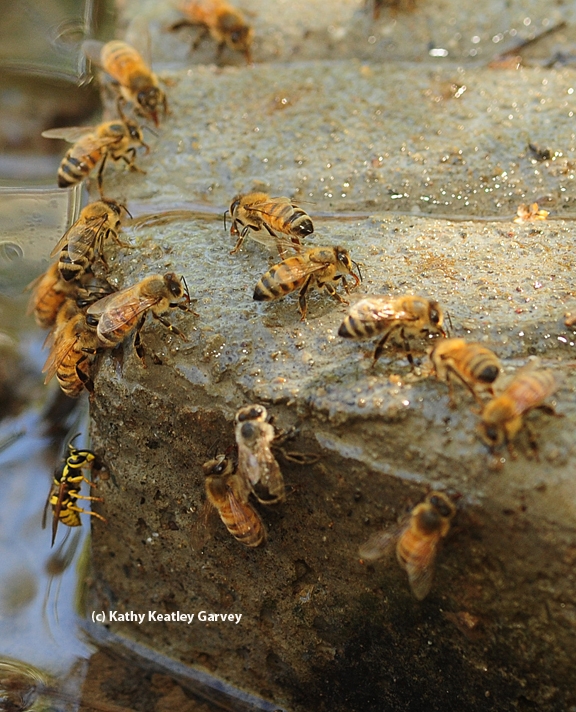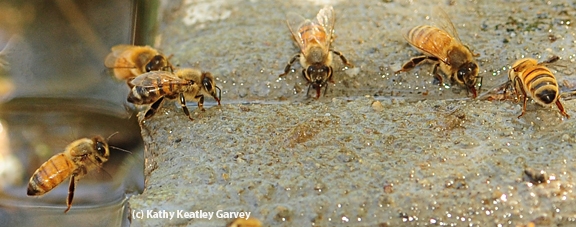Ever seen honey bees foraging for water on your outdoor clothesline?
When Extension apiculturist Eric Mussen of the University of California, Davis, addresses beekeeping associations, he tells them to "always provide water for your bees on your property. Otherwise, they will visit the neighbor's hanging laundry, bird bath, swamp cooler, dog dish, leaky hose connection, etc."?
Bees collect nectar, pollen, propolis (plant resin) and water for their colonies. On very hot days, you'll see scores of bees at a water fountain, bird bath, or pond.
Kim Flottum, editor of the Bee Culture magazine, writes in his book, The Backyard Beekeeper: An Absolute Beginner's Guide to Keeping Bees in Your Yard and Garden: "A summer colony needs at least a quart (liter) of water every day, and even more when it's warm."
Flottum points out: "Water is as necessary to your bees as it is to your pets and to you. Whatever watering technique you choose for your bees, the goal is to provide a continuous supply of fresh water. This means while you are on vacation for a couple of weeks, when you get busy and forget to check, and especially when it's really, really hot--bees always need water."
With temperatures soaring to 100 degrees today in Yolo and Solano counties, that's good advice.
Mussen and Flottum acknowledge that bees are industrious and will find water somewhere even if their regular source is unavailable. "Water is used to dissolve crystallized honey, to dilute honey when producing larval food, for evaporation cooling during warm weather, and for a cool drink on a hot day," Flottum writes in his book.
We've watched bees gathering water from our bird bath. We've seen hawks, doves, squirrels, crows, finches and bees sipping water there--as well as our cat, Xena the Warrior Princess. Not all at the same time, though! The Cooper's Hawk reigns supreme.
At the Harry H. Laidlaw Jr. Honey Bee Research Facility at UC Davis, bees can sip water from a slanted board propped against a slowly dripping faucet, or from the specially designed watering devices at the nearby Häagen-Dazs Honey Bee Haven, a half-acre bee friendly garden that doubles as an educational resource.
Bees know exactly where to return for the same water source. "Foragers seem to seek water sources that are scented," Flottum says.
This could be from a roadside ditch, storm drain, fish pond, dog dish or bird bath.
"Foragers will mark unscented sources of water with their Nasonov pheromone so others can locate the source too," Flottum writes.
Flottum's book is one of the "must-have" books for a beekeeper's library or for anyone wanting to learn more about bees.
You can read more about bees in Mussen's newsletters, from the UC apiaries, posted on his website.
Attached Images:


